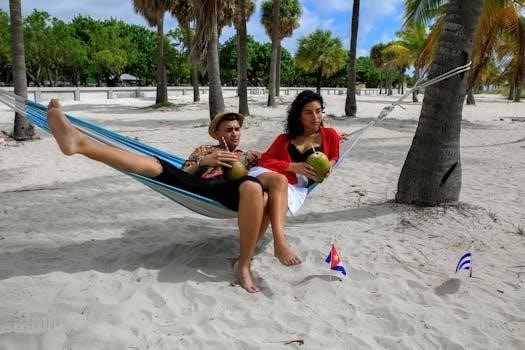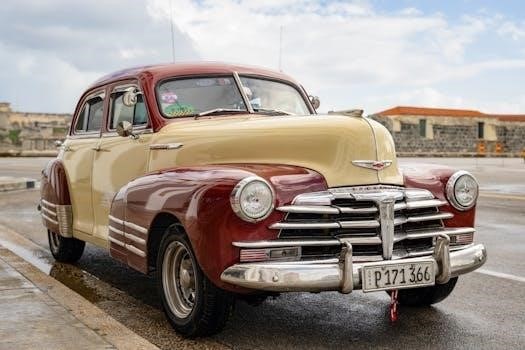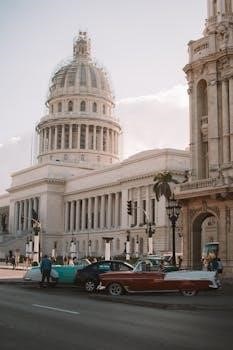listado de precios de la aduana de cuba pdf

Understanding Cuban Customs Tariffs
Cuban customs tariffs are complex‚ involving various regulations and calculations․ These tariffs impact travelers and importers alike․ Understanding these rules is crucial for smooth entry․ Changes in these regulations occur․ The Cuban government sets these tariffs․ It is important to stay updated on the latest changes․
The Cuban Customs Authority oversees the import and export of goods‚ implementing regulations to control trade and revenue․ It operates under the Ministry of Finance and Prices․ These regulations are in place for both commercial and non-commercial items․ The system includes tariffs and duties․ These are applied to imported goods․ The customs authority also manages documentation and inspections; Changes to regulations are periodically issued․ It is essential for travelers and importers to be aware of these updates․ The goal of Cuban customs is to protect national interests․ This is done while adhering to international standards․ The customs process includes declarations․ It also includes assessments of value․ The customs process also includes the payment of duties․ The authority also monitors for abuses of exemptions․ This is done to ensure fairness․ The introduction to Cuban customs involves understanding its legal framework․ It also involves understanding its operational procedures․ It also involves being aware of the latest rules․ This information enables a smoother experience when dealing with Cuban customs․
Key Regulations and Legal Framework
The legal framework for Cuban customs is primarily established by decrees and resolutions from the Ministry of Finance and Prices and the General Customs of the Republic․ Key among these is the Decree-Law 101/2024‚ which modifies the system of tariffs for imports made by individuals and businesses․ This framework includes regulations regarding the valuation of goods‚ payment methods‚ and the classification of products․ Resolution 176/2022 specifies the methods for determining customs duties․ The legal framework aims to align Cuban customs practices with international standards․ It also aims to protect national industries․ The laws govern the import of goods for both commercial and non-commercial purposes․ These regulations outline the rights and obligations of importers and travelers․ They also specify the procedures for customs clearance․ These procedures involve declaration‚ inspection‚ and payment of duties․ The framework also includes measures against smuggling․ It also includes measures against the abuse of exemptions․ Understanding this legal basis is essential for compliance․ This also helps to avoid penalties when dealing with Cuban customs․
Non-Commercial Importation Rules
Non-commercial importation rules in Cuba primarily concern goods brought in by individuals for personal use or gifts․ These rules are distinct from commercial import regulations․ They often involve specific allowances and exemptions․ Cuban customs allows the import of certain items‚ such as food‚ medicines‚ and personal hygiene products‚ without limits on value for a period․ The rules have been updated recently․ However‚ this exemption is not permanent․ Generally‚ there is a limit on the total value of goods allowed without incurring duties․ Exceeding this limit results in the application of customs tariffs․ These tariffs are set at a percentage of the value of the excess․ The rules also specify the permitted quantities and types of goods․ The rules also specify the permitted ways to import non-commercial goods․ Travelers must declare all goods accurately to avoid penalties․ The customs authorities also watch for abuses of non-commercial import rules․ These rules can change frequently․ It is important to check official sources for the most current details before traveling․ The regulations also address how customs duties are applied for non-commercial imports․
Exemptions for Specific Goods
Cuban customs regulations include exemptions for specific types of goods‚ often aimed at supporting the needs of individuals․ These exemptions are typically for non-commercial imports․ Some of the most notable exemptions apply to essential items such as food‚ medicines‚ and personal hygiene products․ These items are often allowed without import duties․ However‚ it is important to note that these exemptions are not always permanent․ They can be subject to change․ The government has extended these exemptions in the past․ The exemptions generally apply to goods sent by individuals to family in Cuba․ The exemptions may be limited to specific quantities of goods․ These exemptions are designed to help residents․ The exemptions are designed to provide relief from customs duties․ It is important to verify the current regulations․ Travelers should be aware of these exemptions․ The exemptions can be revised by the Cuban government․ Always check the official customs website for the latest information․ This ensures accurate understanding of applicable exemptions before traveling․ The specific rules can vary․ The type of goods also affects the exemption status․ It is important to declare all goods truthfully․ The rules are subject to change․ These exemptions are subject to certain conditions․

Limits on Import Value
Cuban customs imposes limits on the value of goods that can be imported without incurring duties․ These limits are crucial for both travelers and importers to understand․ The value limit for personal items is often set at a specific amount․ Any items exceeding this value will be subject to customs tariffs․ It’s essential to accurately declare the value of all imported goods․ The Cuban customs authority assesses the value of items․ The limits may vary depending on the type of goods․ These limits are subject to change by the Cuban government․ Travelers should always verify the latest regulations․ Exceeding the limit results in the application of customs duties․ The current value limit is frequently updated․ The limits are designed to regulate the flow of goods․ The limits also ensure fair taxation․ These limits apply to non-commercial imports․ The limits are different for commercial imports․ It is important to understand how the value is determined․ The value may be based on the original purchase price․ The value may also be based on a standard price․ The limits affect what you can bring into the country․ It is advisable to keep receipts for items purchased․ The limits are different for different types of imports․ The limits are designed to prevent excessive importation․ The limits ensure that goods are properly taxed․ This helps maintain control over imports․
Tariff Calculation Methods
Cuba employs specific methods for calculating customs tariffs․ Understanding these methods is crucial for accurate import cost estimation․ The calculation can be based on the value of the goods․ This is known as “ad valorem” taxation․ It can also be based on a specific rate per unit․ This is known as “specific” taxation․ The Cuban customs authority uses both methods․ The method applied depends on the type of goods․ The process involves assessing the value of imported items․ This value is then used as the base for calculations․ Specific tariffs are applied to specific types of goods․ Ad valorem tariffs are applied as a percentage of the value․ The percentage rate can vary depending on the goods․ The Cuban government sets these rates․ These rates are subject to change․ The calculation may also take into account the origin of the goods․ Preferential rates may apply to goods from certain countries․ It’s important to have all the necessary documentation․ This ensures the correct calculation of tariffs․ Incorrect declarations can lead to penalties․ The customs authority has set procedures․ These procedures are used for tariff calculations․ The calculation process can be complex․ It is advisable to seek assistance from customs experts․ The calculation methods are periodically updated․ Staying updated with the latest rules is very important․ The calculation helps ensure fair trade practices․ These methods are in place to protect local industries․ Understanding these methods will help travelers․

Payment of Customs Duties
Payment of Cuban customs duties is a key part of the import process․ It is crucial to understand the methods and currencies accepted․ The payment is generally required before goods can be released․ This payment can be made at designated customs offices․ The Cuban government has implemented specific procedures for payment․ These procedures must be followed․ Payment can be made in different currencies․ The Cuban Peso is often accepted for residents․ However‚ other currencies like US dollars are used for non-residents․ The specific currency depends on the person’s status․ It is important to check the current rules․ Payment methods may include cash or electronic transfers․ The customs authority specifies the acceptable payment options․ It is vital to obtain a receipt after payment․ This receipt acts as proof of payment․ Failure to pay duties can lead to delays․ It can also lead to confiscation of goods․ The government has taken measures to ensure compliance․ The payment process is regularly reviewed and updated․ It is important to stay updated with the latest requirements․ The customs authorities provide information about payment methods․ It is advisable to consult these resources․ The payment process may vary depending on the type of goods․ The value of goods also affects the payment․ Understanding the process ensures a smooth import․ The payment process is vital for smooth customs clearance․ It is important to plan ahead and prepare the funds․ Proper payment procedures also ensure fair trade․ These rules are designed to protect local industries․ Payment of duties is essential for travelers and importers․
Currency of Payment
The currency of payment for Cuban customs duties is a significant aspect of the import process․ Understanding which currencies are accepted is essential for travelers and importers․ Historically‚ the Cuban Peso (CUP) was used for payments․ However‚ changes in regulations have introduced other options․ The Cuban government allows payment in freely convertible currencies․ These currencies include the US dollar‚ euros‚ and other major international currencies․ The specific currencies accepted may vary‚ depending on the time and the specific customs office․ It is important to stay updated on the latest requirements․ Payment in CUP is generally accepted for Cuban residents․ However‚ non-residents are often required to pay in foreign currencies․ The government has made these changes to facilitate international trade․ The use of foreign currency also helps with managing the local economy․ The currency of payment can affect the overall cost of importation․ Exchange rates will influence the final amount paid․ It is therefore important to check the current exchange rate before making a payment․ The customs authority provides information on acceptable currencies․ Information is usually available on their website․ It is also available at customs offices․ It is important to have the correct currency to avoid delays․ Not having the correct currency may result in extra charges․ It may also lead to delays․ Travelers should therefore have the required currency ready before arrival․ The rules regarding currency can change at any time․ Keeping informed ensures a smooth transaction․ The currency used for payment is crucial for customs clearance․ These rules are intended to streamline the customs process․ The use of multiple currencies is part of Cuba’s economic strategy․
Changes in Customs Regulations
Cuban customs regulations have seen numerous changes over the years‚ reflecting the evolving economic policies of the country․ These changes impact both travelers and importers․ Staying updated is important․ Recent modifications have focused on import restrictions and payment methods․ The Cuban government regularly updates its customs laws․ This is to address various economic and social considerations․ These changes can involve the types of goods that are permitted․ They can also involve the values allowed and the taxes charged․ The government has been adjusting the limits on non-commercial imports․ This affects items like food‚ medicine‚ and personal care products․ These changes are aimed at balancing the needs of the population with the control of imports․ New regulations may include changes to the list of prohibited items․ They may also affect the procedures for declaring goods․ The implementation of new technology also affects custom processes․ The customs authority uses electronic systems․ These systems help to manage and process imports․ The changes also involve the currency in which duties are paid․ The use of foreign currency is now more common․ This reflects the changing financial landscape of Cuba․ The government also adjusts its regulations to manage the flow of goods․ These changes often respond to issues with abuse of the system․ New measures are implemented to prevent commercial activities․ They also prevent the misuse of personal exemptions․ The changes are usually announced through official publications․ These publications include government gazettes and websites․ It is important to consult these sources․ This is to obtain the most accurate and up-to-date information․ These modifications can sometimes be implemented with little notice․ This makes it essential to stay informed․ These changes are intended to improve the efficiency․ They are also intended to modernize the customs system․ The Cuban government continues to adapt its policies․ These policies reflect the country’s ongoing economic and social needs․
Impact on Travelers and Importers
Changes in Cuban customs regulations significantly impact both travelers and importers․ Travelers must be aware of the current limits; They must understand the rules regarding personal belongings․ This includes items such as food‚ medicine‚ and other goods․ Failure to comply can lead to delays․ It can also lead to the confiscation of goods․ The limits on the value of imported items are crucial․ These limits dictate what can be brought into the country․ This can be without incurring additional taxes․ The rules regarding the payment of duties are also essential․ Many now require payment in foreign currency․ This poses challenges for some travelers․ The application of these rules can vary․ This depends on the type of traveler․ It also depends on the frequency of their travel․ Importers face a different set of challenges․ These challenges include the need to navigate the complex tariff system․ They must also stay updated on changes in the law․ They must understand the specific classification of goods․ This is essential for accurate tax calculations․ The payment of duties may involve multiple steps․ This can be both time-consuming and costly․ Changes in customs regulations can affect the profitability of import businesses․ This requires importers to be adaptable․ They must also be proactive in understanding the new rules․ The impact of these changes extends to the Cuban economy․ The changes affect the flow of goods and the availability of products․ They also impact the overall cost of living․ The government’s goal is to maintain control over imports․ It also tries to protect local industries․ At the same time‚ it must ensure the availability of essential goods․ These regulations affect every aspect of the import process․ They also affect the traveler’s experience․ Both travelers and importers must stay informed․ They must seek out reliable sources of information; They must also adapt to the frequent changes․

Resources for Further Information

Measures Against Abuse of Exemptions
Cuban customs authorities have implemented several measures to combat the abuse of import exemptions․ These measures target individuals attempting to exploit the system․ This is done for personal gain or commercial purposes․ One key measure is enhanced scrutiny of frequent travelers․ This scrutiny focuses on those who regularly import large volumes of goods․ Customs officials are now more vigilant; They are closely monitoring travelers who repeatedly bring in items․ These items often fall under the tax-free categories․ The authorities are also employing sophisticated data analysis techniques․ This data analysis helps to identify suspicious patterns․ This can include unusual import volumes or frequencies․ The use of technology in customs operations is increasing․ This allows for a more efficient tracking of goods and travelers․ Another important measure is increased penalties for violations․ This includes fines and the confiscation of goods․ The legal framework for customs has been updated․ This aims to deter those who try to circumvent the rules․ Furthermore‚ the customs authorities are collaborating with other agencies․ This collaboration enhances their ability to detect and prevent fraudulent activities; They are also working with international partners․ This collaboration helps to share information and best practices․ The customs officials are also conducting more frequent inspections․ This is done at various points of entry․ These inspections target both personal and commercial imports․ The government is also focused on educating the public․ This is done through public awareness campaigns․ These campaigns aim to clarify the regulations․ They also emphasize the consequences of non-compliance․ These measures are designed to protect the integrity of the customs system․ They also intend to ensure that exemptions are used appropriately․ They are used for their intended purpose of aiding individuals․ They are not for commercial exploitation․ The goal is to maintain fairness and transparency․ This will allow the system to function effectively․